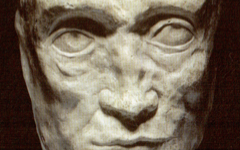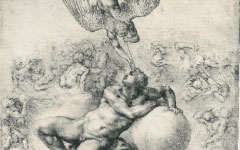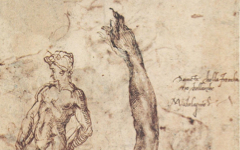Michelangelo’s Sistine Ceiling: Jeremiah (c.1509-10)
Michelangelo once remarked that “in painting, the idea is an image that the intellect of the painter has to see with interior eyes in the greatest silence and secrecy.”1 There are two aspects to the comment. One is that meaning in art is veiled and secret; the other that silence is necessary for contemplation and conception.
That's why the prophet Jeremiah on the ceiling of the Sistine Chapel has his mouth covered and finger extended in the signum harpocraticum, an ancient gesture of silence signifying profound esoteric knowledge.2 This is not surprising because Origen, Christianity's first theologian, was widely read in the Renaissance and his homily on Jeremiah states that you will not understand the prophet's wisdom “if you do not listen in a hidden manner”.3 Jeremiah's books in the Old Testament, like all scripture and art, require allegorical and esoteric interpretation.
In addition Leonardo advised artists to aid their conceptual faculty by remaining solitary and we know of Renaissance artists who literally chased their assistants from the studio in order to study alone like scholars.4
Click next thumbnail to continue
Jeremiah is, as usual, the artist's alter ego and his face may even be the young Michelangelo's idealized conception of what he would look like when old, as Leonardo may also have done to himself in his own "self-portrait".5 Age, after all, symbolizes wisdom.
Click next thumbnail to continue

Top L: Michelangelo, The Prophet Jeremiah (c.1509-10) Detail.
Top R: Vasari, Portrait of Lorenzo de' Medici (1534), Detail rotated and flipped. Oil on canvas. Uffizi, Florence.
Bottom: Diagram of Jeremiah's hand
Click image to enlarge.
The esoteric hint in Jeremiah's gesture is supported by the content of his figure. The clenched part of the prophet's hand contains a caricature of Lorenzo de' Medici, the artist's somewhat imaginary "father-figure" who, he later said, spotted his talent and brought him into the Medici household. If you compare the hand to Lorenzo's posthumous portrait by Vasari, you should see in Jeremiah's fingers the jutting chin, acutely receding upper lip and the ski-jump nose with its distinctive blunt tip. Moreover Jeremiah's pointing finger emerges from a crease representing Lorenzo's closed eye. This thereby unites intellect (eye) with craft (finger).
Click next thumbnail to continue

L: Michelangelo, The Prophet Jeremiah. Detail.
R: Vasari's Portrait of Lorenzo de' Medici Detail flipped.
Click image to enlarge.
There is evidence to suggest that Vasari may have known this though he made no mention of it when he described Jeremiah's figure in his book. Is it coincidence that, when one figure is inverted, both Jeremiah and Lorenzo, gazing down at the same angle, share a similar arm with a hand hanging loosely at the wrist?
Click next thumbnail to continue
That is not all though. If you look at the highlights on Jeremiah's hand you will see a breast with a nipple protruding from its edge. A knuckle is misplaced to give it the appearance of a nipple. Should there be any doubt, there is a phallic-shaped highlight pointing upwards to its left. Once again Michelangelo uses incorrect anatomy to suggest his hidden forms; Jeremiah has a double wrist-joint to create the two-sided penile head. This close combination of sexual gender symbols is yet another example of the persistent representation of androgyny in art as a symbol for the wholeness and fertility of the creative mind. The appearance of Lorenzo, Florence's "king", in Jeremiah's hand is in addition a royal symbol for the purity and perfection of that same mind which is Michelangelo's specifically, ours potentially.6
More Works by Michelangelo
How we know that the young Picasso knew his destiny

Picasso’s Head of Picador with Broken Nose (1903)
Notes:
1. Michelangelo's contemporary Albrecht Dürer said that only good painters can understand art because it "is denied to others, like a foreign language." Little has changed since. The contemporary American artist Philip Pearlstein repeated approvingly that in Michelangelo's day the ordinary man in the street would not have understood the Sistine Chapel and added that it was even more true of his own figurative paintings. And Francis Bacon remarked “Very few people have visual perception, it’s a very rare thing.” This is partly a result of the nature of the visual system which is primed to see the most likely occurrence. It's only when we know what to expect that we can see it. It's a Catch-22 that some minds, not many, are able to work around. Sight's seeming simplicity is why, as Picasso complained, you often hear that someone has no ear for music but never that say she has no eye for painting. Jane Campbell Hutchison, Albrecht Dürer: A Biography (Princeton University Press) 1990, p. 111; Philip Pearlstein Since 1983 (New York: Harry N. Abrams) 2002, pp. 32-3; Richard Davies in Francis Bacon: New Studies (Göttingen: Steidl) 2010, p. 111; Ramachandran, "2D or not 2D" in Richard Gregory et al. (eds.), The Artful Eye (Oxford University Press) 1995, p. 258; André Malraux, Picasso’s Mask, (New York: Holt, Rinehart and Winston) 1976, p. 116.
2. Blech and Doliner, The Sistine Secrets: Michelangelo’s Forbidden Messages in the Heart of the Vatican (New York: Harper Collins) 2008, p. 214; Jeremiah also holds his hand in the same position as Joseph in a later drawing by Michelangelo known as The Madonna of Silence (Hirst 437).
3. Joseph W. Trigg, Origen (London: Routledge) 1998, p. 56.
4. Christopher S. Wood, “Indoor-Outdoor: The Studio around 1500” in Cole and Pardo (eds.), Inventions of the Studio, Renaissance to Romanticism (Chapel Hill: University of North Carolina Press) 2005, p. 37
5. See Abrahams, "Wisdom and Leonardo's Self-Portrait" (2011).
6. Lorenzo, of course, was not a king but in Republican Florence and in the imagination of his contemporaries he often held the same position. In the story of his childhood that the elderly artist told his official biographer, Lorenzo "discovered" Michelangelo and, in bringing the young boy into his large household, allowed him to grow and flourish in a spiritual and intellectual environment.
Original Publication Date on EPPH: 19 Jul 2014. © Simon Abrahams. Articles on this site are the copyright of Simon Abrahams. To use copyrighted material in print or other media for purposes beyond 'fair use', you must obtain permission from the copyright owner. Websites may link to this page without permission (please do) but may not reproduce the material on their own site without crediting Simon Abrahams and EPPH.





